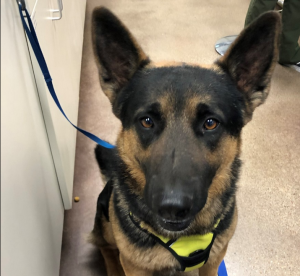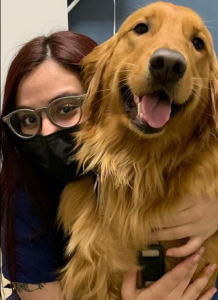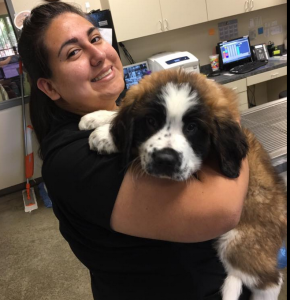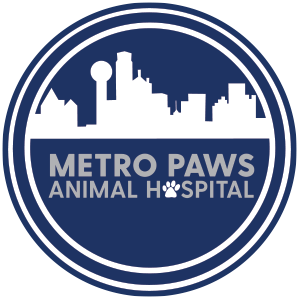What to Look for in Your Big Dog and How Your Veterinarian Will Treat These Issues
If you’ve got a big dog, you know they have some signature traits. They’re often endlessly goofy (or “derpy,” if you will), eager to please, and they generally have no idea about personal space. We love them for all those reasons and many more. Unfortunately, the size of these dogs can sometimes lend themselves to certain physical ailments. If you’ve got a Labrador Retriever, Great Dane, Bernese Mountain Dog, or another of the many large dog breeds, it’s good to be aware of what to look for, as treating these conditions early will nearly always equate to a better prognosis.
In the following article, we’ll be covering the following five conditions large dogs are prone to:
- Hip Dysplasia
- Elbow Dysplasia
- Arthritis
- Bloat
- Dilated Cardiomyopathy
Knowledge is always power, so if you notice any signs or symptoms mentioned below, please call us immediately.
1. Hip Dysplasia
Hip dysplasia is characterized by the instability or abnormal development of one or both hip joints, ultimately leading to degenerative joint disease (arthritis) and subluxation (partial dislocation) of the hip. Hip dysplasia can be seen in almost any breed, but some dogs are more prone to the condition.

Check your German Shephard for bunny hopping.
The three most common dog breeds predisposed to hip dysplasia include:
- German Shepherds
- Golden Retrievers
- Labrador Retrievers
Sometimes, the only thing noticed at home will be a “bunny hopping” type gait or intermittent limping of one or both back legs. A veterinarian can have suspicions after a physical exam. Screening for hip dysplasia involves X-rays which may require the pet to be sedated to get well-positioned images.
These X-ray images may be sent for grading by a veterinary radiologist, which will classify the hips into one of the following categories:
- Excellent
- Good
- Fair
- Borderline
- Mild
- Moderate
- Severe
The dog must be at least two years of age for these kinds of X-rays, but early screening in at-risk breeds can be performed as young as four months old. Treatment options, both surgical and medical management, vary widely based on the severity of the case and the dog’s age. All treatments aim to give your pet a more comfortable and happy life.
2. Elbow Dysplasia
Elbow dysplasia is a general term for multiple congenital abnormalities seen in the elbow.
A dog with elbow dysplasia can have one or multiple of the following:
- Ununited anconeal process (UAP)
- Osteochondrosis (OCD) of the humeral condyle
- Fragmentation of the medial coronoid process (FCP)
- Elbow incongruity

We’ll screen your Retriever pup for elbow dysplasia.
Common breeds predisposed to these diseases include:
- German Shepherds
- Bassett Hounds
- Bloodhounds
- Labrador Retrievers
- Newfoundlands
- Golden Retrievers
- Rottweilers
The dog typically will show intermittent or subtle lameness of one or both front limbs at a young age (<1 year). Specific x-ray views can be used to screen for elbow dysplasia and can also be sent to OFA for grading, but often advanced imaging (CT scan/arthroscopy) is necessary to definitively identify abnormalities. Therapy depends on the type of elbow dysplasia, but surgery with a specialist is typically required.
3. Arthritis
Arthritis, also known as osteoarthritis (OA), is not only seen in humans but also in our pets. It is a chronic joint disease characterized by damage/loss of joint cartilage, thickening of the joint capsule, and new bone formation around the joint, ultimately leading to pain and lameness. Most OA occurs secondary to orthopedic diseases such as hip dysplasia, elbow dysplasia, patellar luxation, and cranial cruciate ligament (CCL). It’s important to note that arthritis is progressive, so treatment is aimed at slowing down the progression of the disease and keeping the pet comfortable. Several medications are available to reduce the severity and progression of arthritis in dogs. For more information, please schedule a visit with your veterinarian.
4. Gastric Dilatation Volvulus (Bloat)
Gastric Dilatation Volvulus (GDV) is a condition that quickly becomes life-threatening and is an emergency requiring immediate veterinary care. GDV happens when the stomach expands with gas (dilatation) and twists on itself (volvulus).
The cause of Bloat in dogs is not entirely understood, but there has been an association with the following:
- Large, deep-chested dogs
- Dogs that are fed a single large meal once a day
- Geriatric dogs
- Genetics
- Stress/anxiety

Pay careful attention to your Bernard babies!
The most common breeds prone to Bloat are:
- Great Danes
- Bernards
- Irish Setters
- Gordon Setters
- German Shepherds
- Weimaraners
The clinical signs of Bloat in dogs include:
- Restlessness/pacing
- Retching/vomiting
- Stretching
- Abdominal distension
- Increased respiratory rate
Diagnostics include complete bloodwork to assess organ function, abdominal x-rays to confirm the diagnosis, and EKG to evaluate for any arrhythmias (commonly seen in the later course of the disease). Dogs typically present in critical condition and require aggressive resuscitation and supportive care before surgical intervention. Once stable enough for surgery, the stomach will be de-rotated and assessed for viability, along with the spleen. Although the dilatation part of the condition cannot be prevented, the twisting (volvulus) can be with a prophylactic gastropexy which permanently attaches the stomach to the abdominal wall. GDVs often have a variable prognosis, and death rates increase with the length of time until surgery. With prophylactic gastropexies in breeds at higher risk, the development of this condition can be significantly reduced. Prophylactic gastropexies are typically done during the spay/neuter procedure.

We’ll check your boxer baby for DCM!
5. Dilated Cardiomyopathy
Dilated cardiomyopathy (DCM) is a disease affecting the muscular layer of the heart characterized by enlargement of the heart and impaired function of the heart. It is one of the most common cardiomyopathies seen in large breed dogs such as Doberman, Irish Wolfhound, Great Dane, St. Bernard, Boxer, Leonberger, Newfoundland, Giant Schnauzer, and others. Genetics is one factor that can play a role in the onset of DCM – others involve nutritional (grain-free diets) and some infectious causes (uncommon).
Clinical signs of dilated cardiomyopathy in dogs include:
- Fainting
- Lethargy
- Weight loss
- Exercise intolerance
Many dogs have no symptoms until they suddenly have signs of heart failure (respiratory distress, coughing, or abdominal distention). Diagnosis is based on an echocardiogram, but chest X-rays can be helpful to evaluate for any fluid in or around the lungs and the lung tissue/vessels. Electrocardiogram (EKG) can also be used to look at the heart rhythm and evaluate for any arrhythmias, but in some cases, a 24-hour EKG (halter monitor) is necessary to fully evaluate the heart rhythm. Cardiac arrhythmias can be serious and may predispose the dog to sudden death. Treatment aims to improve the heart’s function and control the heart rate/arrhythmias if present through heart medications. These medications can be administered by injection for emergency cases or orally in dogs that are stable and for long-term management. DCM is a serious and often fatal disease. The prognosis is variable and depends largely on the dog’s breed, cause, and stability at presentation.
Large breed dogs leave a mark on our hearts as big as their giant, silly paws, so it’s surely not easy to think about them experiencing one of these issues. But it’s best to know the signs so you can call us immediately if you suspect your dog may be experiencing them. If you’d like to discuss any concerns about your large breed dogs, please get in touch with us today!
